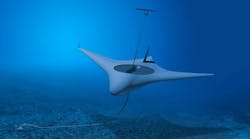Researchers eye digital twins to analyze effect of intermittent communications on unmanned undersea vehicles
ARLINGTON, Va. – U.S. military researchers are asking industry to determine the feasibility of using digital twins to explore the capabilities and missions of future unmanned undersea vehicles (UUVs) -- especially to help researchers understand how sometimes-unreliable and intermittent undersea communications could influence this design approach.
Officials of the U.S. Defense Advanced Research Projects Agency (DARPA) in Arlington, Va., issued a small business innovation research (SBIR) opportunity (HR001121S0007-24) on Tuesday for the Defining and Leveraging Digital Twins In Autonomous Undersea Operations (DELTA) project.
A digital twin is a virtual representation of a system that spans its life cycle, updates from real-time data, and uses simulation and modeling, machine learning, and reasoning to help decision making.
This undersea effort is to determine the feasibility of extending digital twins to autonomous undersea vehicles, and determine the effects of undersea intermittent communications on digital twins under the ocean.
Related: Northrop Grumman predictive-maintenance models to head-off Air Force airframe cracks
Although digital twins have been useful in manufacturing, product development, and design customization, their use in defense and maritime applications have been limited. The DELTA project seeks to determine if digital twins can add value to unmanned undersea missions, and if so, how researchers should employ digital twins.
This effort also will investigate the feasibility of translating digital twins to UUVs; the traditional use of digital twins relies on robust and continuous communications, which are not always available in undersea operations.
A chief aim is to address and overcome intermittent or low-rate data communications, and evaluate the number and size of UUVs will be necessary to realize operational efficiencies, or the kind of maintenance that this approach would require.
Ultimately, researchers believe that digital twins could help Navy commanders understand what their UUVs are doing -- particularly in times of reduced or no communications.
The project's first phase will demonstrate in-depth knowledge of digital twins in undersea vehicle fleets, and the second phase will define the system, and capitalize on phase-one information to build a functional prototype.
Companies interested should submit proposals no later than 12 Oct. 2021 to the DOD SBIR/STTR Electronic Submission website at www.dodsbirsttr.mil/submissions. Email questions or concerns to DARPA at [email protected], with BAA HR001121S0007-24 in the subject line.
More information is online at https://sam.gov/opp/2435dcb17e1b4ef59845f040f800858c/view.
About the Author
John Keller
Editor-in-Chief
John Keller is the Editor-in-Chief, Military & Aerospace Electronics Magazine--provides extensive coverage and analysis of enabling electronics and optoelectronic technologies in military, space and commercial aviation applications. John has been a member of the Military & Aerospace Electronics staff since 1989 and chief editor since 1995.
